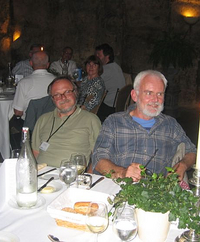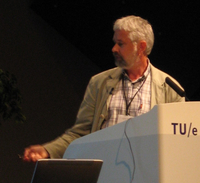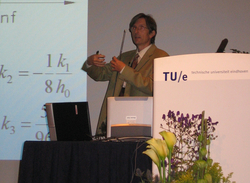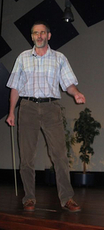 |
Written by Hinke Osinga
University of Bristol, UK |
August 8-12, 2005
Eindhoven University of Technology
The Netherlands |
The fifth
EUROMECH Nonlinear Dynamics Conference is organised every three
years since 1993 under the auspices of the European Mechanics
Society (EUROMECH). This series of so-called ENOC conferences
continues a tradition of twelve International Conferences on Nonlinear
Oscillations (ICNO) in East-European countries, that started in 1961
in Kiev,
| Ukraine. ENOC-2005 was the
first conference in the series to include research areas beyond the
specific context of mechanical systems, and as such there were a large
number of first-time ENOC participants, including myself. In this
respect, the conference was a huge success in bringing together such a
broad range of researchers in nonlinear dynamics. On the other hand
this meant that the programme was packed, with 14 minisymposia running
in parallel! The minisymposia were series of themed talks running over
several days, so that participants would mostly attend one
specific minisymposium. Hence, there was too little opportunity to go to other
talks and research interactions between fields were largely
limited to the plenary lectures. |
|
 |
| The international music ensemble Barocco
Locco performs during the opening ceremony; photograph by Gábor
Orosz |
 |
|
The real success of ENOC-2005 was the quality
and breadth of research topics in the plenary lectures. All plenary
speakers had gone to great lengths to provide a professional
electronic presentation of the highest quality and the lecturers were
delivered with great enthusiasm. Phil Holmes gave the opening lecture,
where he provided a historical overview of dynamical systems
theory. Of course, many of us know the story of King Oscar of Sweden
who challenged the learned men of his time to proof the stability of
the planetary system, and how Poincaré won it by showing that
this is not true. However, Phil managed to add lots of details unknown
to most: for example, he read excerpts from letter aloud in perfect
French, fortunately followed by a translation. He discussed work by
Cartwright and Littlewood, Smale, Kolmogorov, Arnol'd and Moser and
showed examples of observations of chaotic dynamics. At the request of
many in the audience, Phil has made his lecture slides available
online in the DSWeb
Tutorials section. During the conference, Phil Holmes was also
honoured at the conference banquet on the occasion of his 60th
birthday. |
| Edgar Knobloch and Phil Holmes at the conference
banquet listen to a speech by Gábor Stépán;
photograph by Alexander Vladimirsky |
 |
|
 |
| Leo Maas
(left) and Gábor Stépán; (right); both
photographs by Gábor Orosz. |
| Another
highlight was the lecture by Jaques Laskar on "Long Term Evolution of
the Terrestrial Planets Spin Axis". He discussed possibilities on why
Mercury is trapped in a 3:2 spin orbit resonance, why Venus is
rotating in a retrograde way, and what we can say about the
past |
 |
|
obliquity of Mars, even
though it is now chaotic. He also gave a fascinating explanation of
the effect of the spin axis of Earth on our global climate. Namely,
how the position of the north pole can move away from the spin axis as
a result of the moon being pushed away due to the tidal dissipation,
which slows down Earth. This obliquity can vary as widely as 20°
- 90°! Jaques emphasized that one can give all sorts of
explanations of things that we observe today, but the point is to
provide evidence why a certain explanation is actually the correct
one. Since the dynamics ranges over billions of years, it is not easy
to verify anything, which makes is obviously difficult to come up with
convincing predictions for the future. |
|
 |
| Jaques Laskar;
photograph by Alexander Vladimirsky. |
Mark Levy;
photograph by Alexander
Vladimirsky. |
The complete list of plenary talks:
- Phil Holmes (Princeton University)
- Ninety plus Thirty
Years of Nonlinear Dynamics: More is Different and Less is
More
- Leo Maas (Royal Netherlands Institute for Sea Research)
- "Wave Attractors: Linear Yet Nonlinear"
- Gábor Stépán (Budapest University of
Technology & Economics)
- "Delay, Parametric Excitation and the Nonlinear Dynamics of Cutting
Processes"
- Jon Juel Thomsen (Technical University of Denmark)
- "Slow High-Frequency Effects in Mechanics: Problems, Solutions,
Potentials"
- Jacques Laskar (Institut de Mécaniques Céleste et
de Calcul des Éphémérides)
- "Long Term Evolutions of the Terrestrial Planets Spin Axis"
- Thor Fossen (Norwegian University of Science and Technology)
- "A Nonlinear Unified STate-Space Model for Ship Maneuvring and
Control in Seaway"
- Mark Levi (Penn State University)
- "Geometry of Vibration Stabilization and Some Applications"